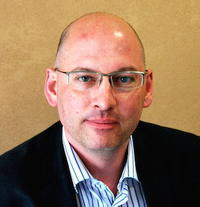Digital citizen, digital patient: EMIF makes it as good to give as to receive
An Interview with Nigel Hughes, Scientific Director, Quantitative Sciences at Janssen Research and Development

“There still remain challenges, but I do think in EMIF-AD, EMIF-MET and the EMIF platform, we have now got models for sharing medical data,” says Nigel Hughes, of Janssen Pharmaceutica, EMIF platform co-lead.
By removing barriers to data exchange, EMIF has provided potent demonstrations of the power of pooling resources in Alzheimer’s disease and metabolic disorders. These exemplars are incentivising data sharing, says Nigel Hughes.
Data sharing is easier to said than done. There are different types of data, varying data quality, different source populations, cohorts and registries with which to contend – to say nothing of the need to overcome the tug of ownership or the time-consuming nature of making your data available to others.
The European Medical Information Framework (EMIF) programme aimed to remove this friction by putting in place interoperability standards, a governance compact and compiling a catalogue of relevant data sources (from electronic health records to cohorts), forming a nexus for the re-use of health data.
“There still remain challenges, but I do think in EMIF-AD, EMIF-MET and the EMIF platform, we have now got models for sharing medical data,” says Nigel Hughes, of Janssen Pharmaceutica, EMIF platform co-lead. “It is evident no one data source represents a universal truth; you need the strength of numbers. By opening the way of pooling data, EMIF has made it possible to demonstrate the value of sharing.”
EMIF-AD and EMIF-MET are intended to be pathfinders of the ‘how to’ of pooling medical data and – by using shared data to discover early biomarkers of disease – as demonstrators of the added value that comes from sharing.
“The idea is to be able to pick up on extreme phenotypes – that can be very informative – in contrast to the mass of subjects in the middle,” Hughes says.
Without EMIF, it would not have been possible to assemble such large data sets in such a short time. Most of the cohorts are relatively small and tend take an in depth look at a few specific variables, rather than taking in the broad sweep of potential disease pathology.
“There may only be a few hundred or so subjects in each cohort. Given this, the ability to unify these data sets is very powerful,” says Hughes.
Pooling cohorts can also provide the basis for carrying out different kinds of studies that individual cohorts could not support. For example, it may be possible to track the natural history of a disease against specific biomarkers or to look at what medication, or not, subjects were taking and how that influences the trajectory of a disease.
New knowledge from historical data
“EMIF-AD and EMIF-MET have shown how important existing data sources are and the potential for learning from what we have now,” Hughes says. While it can be a challenge to work with disparate and historical data, the rewards are there, he believes. “However, it is critical to have the analytical tools to interpret the data and that can be a concern. The quality must be maintained.”
In addition, EMIF has created a space for collaboration between academics, clinicians and pharma, which is promoting the translation of publicly-funded research and, in turn, engendering trust.
For Hughes, this is one of the most valuable aspects of the programme. “Some days, I am working more with collaborators from academia or from other companies than with my own Janssen colleagues. That is not an everyday occurrence for most people and is one of the successes of EMIF.”
With the EMIF programme due to finish at the end of the year, attention has turned to preserving its value for the future. The hope is to secure an informal extension until June 2018, both to complete all work packages and work on preserving the legacy.
Since EMIF was conceived five years ago, much has changed in terms of the technology and the perception of real world evidence, Hughes noted.
“It has all exploded. We are evaluating how EMIF can be linked into these changes and how EMIF feeds into the next wave of IMI projects.”
Nigel Hughes will be a speaker at the event “EMIF, Digital Citizen, Digital Patient” on 28-29 June in Tallinn, Estonia


